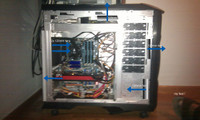You did not address or test air pressure. I spent many days testing multiple formats such as the tests above at my previous position and when I included air pressure, the whole story changed.
Positive air pressure in a case, that has optimal channels for air movement, will cool components better than neutral, or negative pressure.
All else equal, the positive air pressure creates more small eddies that pull more heat from the surface of components, which would otherwise be missed.
You can test this, grab a good tower case, with a bottom mounted PSU, well groomed cabling, and make sure the case has no perforated walls (which defeats the purpose of air pressure testing). If you have 6 fans, 3 point in and 3 point out, in any configuration, it will cool less effectively than arranging the same 6 fans in a 4 in 2 out configuration.
Try it and see if you get the same results...also any thermodynamic engineers care to join in? I am no engineer, just interested.


